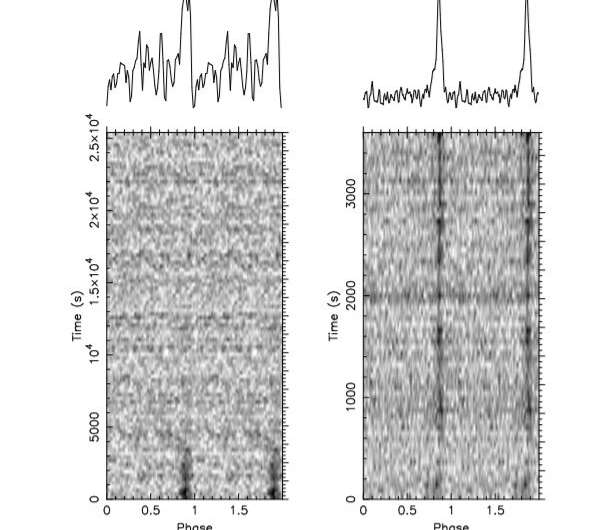Intensity as a function of time and spin phase for the two detections of the new eclipsing redback pulsar 47 Tuc ad. Left panel: Parkes observation made on 2004/05/27. Right panel: MeerKAT discovery observation. Credit: Ridolfi et al., 2021.
Using the MeerKAT radio telescope array, an international team of astronomers has detected eight new millisecond pulsars. The newfound objects are located in six globular clusters. The finding is reported in a paper published March 8 on the arXiv pre-print repository.
Pulsars are highly magnetized, rotating neutron stars emitting a beam of electromagnetic radiation. The most rapidly rotating pulsars, with rotation periods below 30 milliseconds, are known as millisecond pulsars (MSPs). Astronomers assume that they are formed in binary systems when the initially more massive component turns into a neutron star that is then spun up due to accretion of matter from the secondary star.
A class of extreme binary pulsars with semi-degenerate companion stars is dubbed "spider pulsars." These objects are further categorized as "black widows" if the companion has extremely low mass (less than 0.1 solar masses), while if the secondary star is heavier, they are called "redbacks."
Now, a group of astronomers led by Alessandro Ridolfi of the Cagliari Observatory, Italy, reports the detection of eight new MSPs, out of which five are binary systems and three turned out to be faint isolated pulsars. The discovery was made using the 64-dish MeerKAT radio telescope array in South Africa.
"We have used the MeerKAT radio telescope to conduct a first census of pulsars in nine selected globular clusters. As part of this program, we have carried out a deep search for new pulsars using the 1-km core of the array at L-band, as well as a few follow-up observations with different configurations, two of which exploited the full array and the tiling capabilities of the TRAPUM backend. We have discovered eight new MSPs in six different clusters," the astronomers wrote in the paper.
Five new MSPs, designated 47 Tuc ac, 47 Tuc ad, NGC 6624G, M62G, and Ter 5, were found in binary systems, while the objects NGC 6522D, NGC 6624H and NGC 6752F, are faint isolated MSPs. The spin periods of the newfound pulsars are within the range from 2.74 to 8.48 ms.
According to the paper, 47 Tuc ac (spin period of 2.74 ms) and 47 Tuc ad (spin period of 3.74 ms) are eclipsing "spider pulsars" with low-mass companions and regular occultations of their pulsed emission. 47 Tuc ac was found to be a "black widow" with an orbital period of about 0.18 days and a minimum companion mass of 0.0075 solar masses. With an orbital period of approximately 0.32 days and a minimum companion mass of about 0.2 solar masses, 47 Tuc ad turns out to be a "redback." Both MSPs are located in the globular cluster 47 Tuc, some 15,300 light years away from the Earth.
With a spin period at a level of 6.09 ms, NGC 6624G is a binary MSP with a highly eccentric orbit in the cluster NGC 6624. It has an orbital period 1.54 days, pulsar mass of around 2.1 solar masses and its companion is estimated to be about half as massive as the sun. The astronomers assume that the companion star could be either a massive white dwarf or a neutron star. Another MSP found in this cluster, designated NGC 6624H, is isolated and has a spin period of approximately 5.13 ms.
M62G is a binary MSP with a circular orbit located in a massive cluster M62, some 22,000 light years away. It has a spin period of about 4.61 ms, orbital period of around 0.77 days and the mass of its companion is estimated to be at least 0.1 solar masses.
The remaining binary MSP, designated Ter 5 an (spin period of 4.8 ms), has a slightly eccentric orbit with the longest orbital period (about 9.62 days) out of the newly detected five binary pulsars. The secondary object in this system is assumed to be a white dwarf with a minimum mass of 0.43 solar masses. The object is part of the Ter 5 globular cluster located in the galactic bulge.
The isolated pulsars NGC 6522D and NGC 6752F have spin periods 5.53 ms and 8.48 ms, respectively. NGC 6522D resides in the cluster NGC 6522, which is at a distance of about 25,000 light years, close to the center of our galaxy. When it comes to the slowest spinning object reported in the paper, it is located in a core-collapsed cluster known as NGC 6752, some 13,000 light years away.
More information: Eight new millisecond pulsars from the first MeerKAT globular cluster census, arXiv:2103.04800 [astro-ph.HE] arxiv.org/abs/2103.04800
© 2021 Science X Network
























